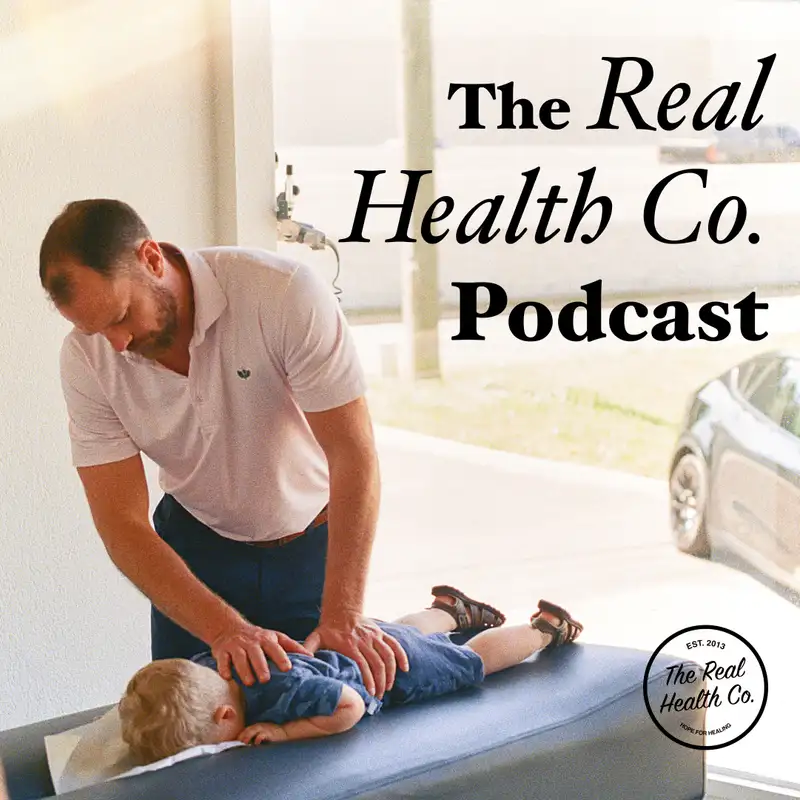 Episode 137
Episode 137
· 14:49
Well, back to another episode of the Real Health Podcast. Today, the title is labs that actually change outcomes. So lab values to test that actually change health outcomes. These are labs that are typically not tested in routine physical exams, and so I wanna provide you with some content here so that you can bring it to the table on your next physical exam and say, hey, these are things that we should be looking at. Also, in a world of of, like, online lab testing, it's like, hey, Well, I'm gonna spend $500 or $300 on all these labs, but do they actually matter?
Dr. Barrett:Are they gonna move the needle? And so these are, like, categorized, and within each category, I'm gonna give you a couple labs that actually change health outcomes. So make sure you're taking notes because we're gonna fly through this material, and it's gonna be, super, like, specific. So let's get into it. We're gonna talk about labs and specifically categories of, like, clinical clinical impact, and I'm gonna give you some interpretation tips.
Dr. Barrett:So what are these labs, if they're off, what do what do they mean? And interventions that move the needle. So let's talk about the first category, and I and I put this as metabolic function, metabolic function. Okay? Obviously, know that chronic disease fundamentally is built upon a foundation of a dysfunctional metabolism, okay.
Dr. Barrett:So insulin resistance is at the core of it. So what labs are vital at moving the needle of metabolic health? Well, the first one is fasting insulin. Fasting insulin should be less than six, less than six. So it is one of the best, most predictive markers of metabolic dysfunction in future disease.
Dr. Barrett:What is your fasting insulin levels? You need to know that. It correlates with aging, cancer risk, cardiovascular disease, and mitochondrial impairment. It's that important. Number two, hemoglobin A1C.
Dr. Barrett:Optimally should be between like four point eight and five point two. It reflects cellular aging. Why? Because elevated blood glucose can create long term glycation end products. It's fancy word for aging, cellular aging.
Dr. Barrett:So hemoglobin A1c, HbA1c should be between four point eight and five point two. And the last one is what is your glucose levels, k, multiplied by your insulin levels and divided by four zero five. This is what we call the HOMA IR, insulin resistance. Okay? It actually reflects insulin resistance better than glucose and hemoglobin A1C alone.
Dr. Barrett:So you need to know your glucose levels, and you need to know your insulin levels, and those two combined, less than one point o is optimal. When we look at metabolic function, fasting insulin, glucose and insulin divided by four zero five, hemoglobin A1c. Those are my top three recommendations. Now how do we turn the needle? If we are elevated or not in the optimal range on those labs, how do we move the needle?
Dr. Barrett:Well, time restricted feeding, paleolithic diet, maybe even a ketogenic diet to reduce carbohydrates, and daily movement. Those strategies will create metabolic flexibility. Number two, inflammation. So inflammation control and immune regulation. So these are for inflammation, okay?
Dr. Barrett:Number one is what we call HSCRP, okay, or C reactive protein. Should be as close to zero as possible, for sure less than one. This is your global inflammation marker. It's linked to cardiovascular disease, neurodegenerative conditions, and cancer risks. It's important to not test when you're sick because CRP can elevate if you've just gotten over a viral condition or bacterial infection, okay?
Dr. Barrett:But CRP should be looked at every year. Number two, ferritin. The optimal is about fifty to one hundred, okay? And fifty to one hundred nanograms per milliliter. Iron overload.
Dr. Barrett:You can actually have too much iron. Iron overload creates oxidative stress inflammation. But too little iron can create hypoxia, not enough oxygen being delivered to your muscles, tissue, and body. Okay? But you gotta be looking at ferritin.
Dr. Barrett:Number three, homocysteine. Homocysteine is one of my favorite markers to test for. The optional range is under eight, so about six to eight, okay? It is a marker of methylation health, okay? But when homocysteine is high, it drives chronic inflammation mainly of the cardiovascular system and also the brain, right?
Dr. Barrett:The way we reduce homocysteine genetically is through a pathway called methylation. B6, B9, B12, homocysteine is a great predictor of whether or not you're methylating properly in your body. Methylation is massive when it comes to detoxification. Obviously homocysteine is associated with cardiovascular risk if it's elevated. So homocysteine is another marker.
Dr. Barrett:When these areas are out of range, we're reducing inflammation. Again, nutrition, maybe we're doing high dose omega three fatty acids or or even methylated B vitamins. Number three, hormone resilience. What should we be looking at other than just your standard hormone profile? The first is TSH is great on your thyroid panel, but if you're not looking at reverse T3 to see how much of your body, how much hormone your body's converting from T3 to reverse T3, which is a it reflects mitochondrial thyroid hormone activation, and it's not just TSH, this is very, very important.
Dr. Barrett:Make sure you're looking at free T3 and reverse T3 on your next thyroid panel. Number two, DHEA. DHEA. This is a neurosteroid. It is a mitochondrial protector and it's responsible for converting to testosterone and estrogen levels, And so it is an anti aging biomarker, DHEA, specifically S, DHEAS.
Dr. Barrett:Last one, if you are stressed and you know you're stressed and maybe you feel anxious, maybe you feel tired around 2PM like you crash, maybe you just don't wake up with enough energy anymore, do a cortisol salivary collection throughout the day. So you do it in the morning, do it in the later part of the morning, do it part of the early afternoon, and then do it in the evening. Those four tests of your cortisol levels look at your circadian rhythm, and can help you understand if the way you feel is associated with low cortisol. In essence, adrenal burnout. A lot of this can be supported through adaptogens, ashwagandha, circadian rhythm resets, know, getting off blue light devices, waking up the same time every day, stress management, it can help balance all these hormones.
Dr. Barrett:Number four, when looking at the gut, one of my favorite things to look at is doing what we call a GI map. A GI map is a test from a company called Diagnostic Labs that looks at multiple things. Look at your commensal bacteria, infectious load, opportunistic infections, parasitic infections, viral, H. Pylori. It looks at leaky gut syndrome markers, inflammation markers of the gut.
Dr. Barrett:So if you're struggling with digestive issues, one of my favorite tests to run is called a GI MAP. Let's look at the cardiovascular system. What markers do you wanna make sure you're looking at besides HDL, LDL, total cholesterol, triglycerides? The first one, APO B, or apolipoprotein B, APO B. Optimal is less than 80.
Dr. Barrett:It's more predictive than LDL C for atherosclerosis. K? Apolipoprotein B. Number two, LPA. LPA.
Dr. Barrett:It's a genetic marker, so this is more associated with genes. And high equals the higher atherogenic potential, so your body's ability to generate atherosclerosis. Okay? Number three, fibrinogen. Make sure you're looking at fibrinogen.
Dr. Barrett:It reflects your coagulation system. Okay? So the thickening of your blood. Should optimal is less than 300. These are tests that anyone can do, and you can request them.
Dr. Barrett:Apolipoprotein B or ApoB, LPA, and fibrinogen. Now, if they're elevated, what are some strategies? Fasting, right? Reversing insulin resistance, omega-three fatty acids, addressing the insulin issue, and maybe even working within the vascular endothelial, like beet powder's fantastic for nitric oxide production. But generally, we're gonna reduce inflammation by reversing insulin resistance, getting your body moving, and maybe it's genetic markers that you have to look at as well.
Dr. Barrett:Number six. This is more fringe, but we're gonna use the term here cellular aging. How old are your cells? Okay, now when we look at the labs associated with cellular aging, the first one you gotta make sure is in range is vitamin D. Vitamin D is so essential at the natural or normal aging process.
Dr. Barrett:It should be between 60 to 80. When you look at a blood test, sixty to eighty nanograms per milliliter is the ideal range. Number two, going back to CRP. CRP is a very important marker for aging. Number three, this is a little fringe that you got to go to a specialty lab for, but you can actually test your telomeres.
Dr. Barrett:There's a company called SpectraCell that does this, and your telomere length will actually tell you how old your cells are. You may be 50 in birth years, but your body may be 30 years old based on your telomere, or it could be 70 years old based on your telomere. So knowing your telomere length gives you an idea of how old you are from a cellular perspective. Let's talk about bonus labs. Number seven.
Dr. Barrett:These bonus labs can track how you feel. They they they make a a direct there's a direct correlation with how you feel in these markers, labs, or data. Okay? So what's one of the things that I look at in the office every time with patients is called heart rate variability, HRV. You can track this through Oura Ring, Whoop devices, but knowing your heart rate variability is a great indicator of how well your body's adapting to stress.
Dr. Barrett:Number two, looking at like a continuous glucose monitor, a CGM. A lot of companies allow you to purchase these online now, and you can look at how your blood sugar is, how stable it is throughout the day. Are there peaks and valleys? And if you're on that roller coaster, you're gonna feel the effects of that. If we're steady, we're gonna have quality energy, and we're gonna be very metabolically flexible.
Dr. Barrett:So the big two, heart rate variability and a CGM are kind of like biohackers tools of data to learn more about their body and how to optimize it. When looking at the labs today, right, what I would suggest is not necessarily running all these labs, but to know, hey, I want to look at this area and test these markers, and if there's any out of range, be intentional with addressing those markers rather than just taking, you know, ten to fifteen supplements every day and hoping for the best. Or just going online and buying this massive test that doesn't test any of these important markers. Right? Be intentional.
Dr. Barrett:Right? Be targeted with your approach so you can have a targeted response. Don't get fooled by just buying something where you're not seeing some of these markers. So I hope today was super helpful for you. I know it was heady.
Dr. Barrett:You may have to replay it, take notes, but these are the markers that will help you move the needle in your health care journey. Thanks for listening to another episode of the Real Health Podcast. Our passion is to add value to your health care journey. Anything that we do, we want to do it within a community to help as many people as possible. Thanks for listening of Real Health Podcast.
Dr. Barrett:If you could like, if you could subscribe, and you can share, it would help our mission to reach as many people with real health that produces real results for real people.

Listen to The Real Health Co. Podcast using one of many popular podcasting apps or directories.